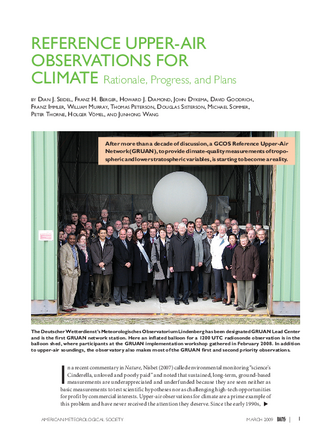Title
Reference Upper-Air Observations for Climate: Rationale, Progress, and Plans
Authors
Dian J. Seidel, Franz H. Berger, Franz Immler, Michael Sommer, Holger Vömel, Howard J. Diamond, John Dykema, David Goodrich, William Murray, Thomas Peterson, Douglas Sisterson, Peter Thorne, Junhong Wang
Published
by Bulletin of the American Meteorological Society (BAMS) at March 2009
Abstract
While the global upper-air observing network has provided useful observations for operational weather forecasting for decades, its measurements lack the accuracy and long-term continuity needed for understanding climate change. Consequently, the scientific community faces uncertainty on key climate issues, such as the nature of temperature trends in the troposphere and stratosphere; the climatology, radiative effects, and hydrological role of water vapor in the upper troposphere and stratosphere; and the vertical profile of changes in atmospheric ozone, aerosols, and other trace constituents. Radiosonde data provide adequate vertical resolution to address these issues, but they have questionable accuracy and time-varying biases due to changing instrumentation and techniques. Although satellite systems provide global coverage, their vertical resolution is sometimes inadequate and they require independent reference observations for sensor and data product validation, and for merging observations from different platforms into homogeneous climate records. To address these shortcomings, and to ensure that future climate records will be more useful than the records to date, the Global Climate Observing System (GCOS) program is initiating a GCOS Reference Upper-Air Network (GRUAN) to provide high-quality observations using specialized radiosondes and complementary remote sensing profiling instrumentation that can be used for validation. This paper outlines the scientific rationale for GRUAN, its role in the Global Earth Observation System of Systems, network requirements and likely instrumentation, management structure, current status, and future plans. It also illustrates the value of prototype reference upper-air observations in constructing climate records and their potential contribution to the Global Space-Based Inter-Calibration System. We invite constructive feedback on the GRUAN concept and the engagement of the scientific community.
Citation
Seidel, D., F. Berger, F. Immler, M. Sommer, H. Vömel, H. Diamond, J. Dykema, D. Goodrich, W. Murray, T. Peterson, D. Sisterson, P. Thorne, and J. Wang, 2009: Reference Upper-Air Observations for Climate: Rationale, Progress, and Plans. Bull. Amer. Meteor. Soc., 90, 361–369, doi: 10.1175/2008BAMS2540.1.
